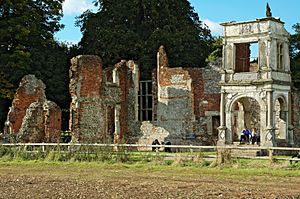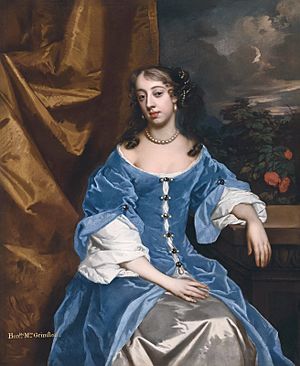Sir Samuel Grimston, 3rd Baronet facts for kids
Quick facts for kids
Sir Samuel Grimston
|
|
|---|---|
| Member of Parliament for St Albans | |
| In office 1689–1699 |
|
| Preceded by | George Churchill Thomas Docwra |
| Succeeded by | George Churchill Joshua Lomax |
| In office 1679–1685 |
|
| Preceded by | Sir Thomas Blount John Gape |
| Succeeded by | George Churchill Thomas Docwra |
| In office 1668–1679 |
|
| Preceded by | Richard Jennings Thomas Arris |
| Succeeded by | Sir Thomas Blount John Gape |
| Personal details | |
| Born | 7 January 1643 |
| Died | 1 October 1700 (aged 57) |
| Spouses |
Lady Elizabeth Finch
(m. 1670; Lady Anne Tufton
(m. 1673) |
| Parents | Sir Harbottle Grimston, 2nd Baronet Mary Croke |
| Residence | Gorhambury House |
Sir Samuel Grimston, 3rd Baronet (born January 7, 1643 – died October 1700) was an important English politician. He lived at Gorhambury House in Hertfordshire. He held the title of Baronet, which is a special inherited title.
Contents
Early Life and Family Background
Samuel Grimston was born on January 7, 1643. He was one of six sons born to Sir Harbottle Grimston, 2nd Baronet. Sadly, Samuel was the only one of his brothers who lived longer than his father.
His mother was Mary Croke. She was the daughter of Sir George Croke, who was a high-ranking judge. Samuel's father was a well-known lawyer and a member of a religious group called the Presbyterians.
Political Career and Public Service
Samuel Grimston became a Member of Parliament (MP) for St Albans. This means he was chosen by the people to represent them in the English Parliament. He was first elected in May 1668.
He served as an MP for many years. He was re-elected in 1679 and again in 1680. However, during the time King James II was ruling, Samuel Grimston did not hold any public office. It is said that the king did not like him.
Return to Parliament
In 1683, Samuel Grimston inherited his father's title and lands. This included Gorhambury House. He then returned to Parliament. He was elected to the Convention Parliament on January 22, 1689.
From that time until May 1699, he continued to represent St Albans in Parliament. He was a steady presence in the government for a long time.
Helping Others: A Challenge
In 1692, Samuel's sister-in-law, Sarah Seymour, the Duchess of Somerset, passed away. She had set up a special charity called the Duchess of Somerset's Hospital. This hospital was meant to help people in need.
The Duchess left her estate to support this hospital. Samuel Grimston was one of the people trusted to make sure her wishes were carried out. However, he did not immediately give the land and money to the hospital. He only did so after a court ordered him to.
Personal Life and Family
Samuel Grimston was married twice. His first wife was Lady Elizabeth Finch. She was the oldest daughter of Heneage Finch, 1st Earl of Nottingham. They got married on February 14, 1670.
They had one daughter together:
- Elizabeth Grimston (died 1694). She later married William Savile, 2nd Marquess of Halifax in 1687. Lady Elizabeth Finch passed away in 1672.
Second Marriage and Legacy
On April 17, 1673, Samuel Grimston married his second wife. She was Lady Anne Tufton. She was the sixth daughter of John Tufton, 2nd Earl of Thanet. Her mother was Lady Margaret Sackville.
Samuel and Anne had a son and a daughter. However, both of their children died when they were very young. When Samuel Grimston passed away in October 1700, his special Baronet title ended. This is because he had no surviving sons to inherit it.
Samuel Grimston left his family's estates to his great-nephew. This was William Luckyn Grimston. William later became the 1st Viscount Grimston. Samuel had also bought more land, adding to the family's wealth.
His Grandchildren
Through his daughter, Lady Elizabeth, Samuel Grimston had a granddaughter. Her name was Lady Anne Savile (1691–1717). She married Charles Bruce, 4th Earl of Elgin.
Arms
 |
|



